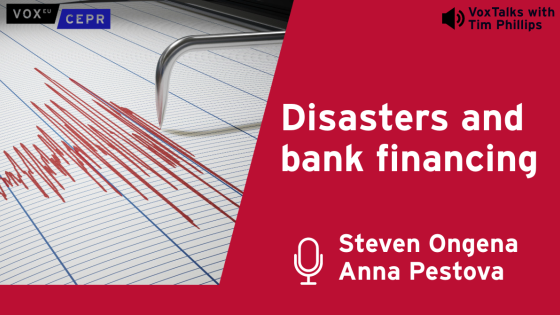The aftermath of the 2007-2009 financial crisis resulted in the widespread adoption of tougher bank regulation, exemplified by the 2010 Accord of the Basel Committee on Banking Supervision, known as Basel III.
However, a concern has emerged about the possibility that the effectiveness of the new regulation may be hindered by a shift of intermediation away from regulated banks and into the shadow banking system. As noted by Hanson et al. (2011), “[w]hile higher capital and liquidity requirements on banks will no doubt help to insulate banks from the consequences of large shocks, the danger is that they will also drive a larger share of intermediation into the shadow banking realm.”
Our recent paper (Martinez-Miera and Repullo 2018) contributes to this debate by proposing an analytical framework to assess the effects of bank capital requirements on the structure and risk of the financial system. In particular, we address issues such as:
- What is the difference between regulated and shadow banks, and how do they differ from direct market finance?
- What type of borrowers are funded by them?
- How does bank capital regulation affect lending through these channels, and
- How does the existence of shadow banks affect the effectiveness of this regulation?
We consider two types of bank capital regulation: risk-insensitive (or flat) and risk-sensitive capital requirements. The former broadly correspond to the 1988 Accord of the Basel Committee (Basel I), while the latter correspond to the 2004 (Basel II) and 2010 (Basel III) Accords (although Basel III combines risk-sensitive capital requirements with a risk-insensitive leverage ratio). We highlight the different effects that these regulations have on the equilibrium market structure, with especial emphasis on whether they shift some types of lending from regulated banks into shadow banks or direct market finance, as well as their impact on the overall risk of the financial system.
Our analysis shows that tighter risk-insensitive (risk-sensitive) capital requirements can lead to a shift of intermediate (high) risk entrepreneurs from regulated to unregulated sources of finance. Although the probabilities of default of loans to entrepreneurs that remain in the regulated banking sector go down, the probabilities of default of loans to entrepreneurs that switch go up. The net effect may be a riskier financial system. For this reason, the design of optimal bank capital regulation has to take into account the existence of unregulated finance, whose presence imposes a constraint that leads to lower capital requirements.
Financial sector structure
To analyse the links between capital requirements, financial market structure and financial stability, we focus on the role of competitive banks as intermediaries between entrepreneurs of different risk types, who need funds for their investment projects, and (uninsured) investors. Entrepreneurs are penniless and their risk types are observable. Banks can screen entrepreneurs’ projects at a cost, which reduces their probability of default. We assume that screening is not contractible, so there is a moral hazard problem, which is the key informational friction in the model.
In the presence of the aforementioned moral hazard problem, (inside) capital provides ‘skin in the game’, serving as a commitment device to screen borrowers. However, bank capital is costly so there is a trade-off. For some borrowers, banks may be willing to use more expensive equity in order to ameliorate the moral hazard problem and reduce the cost of uninsured debt.
However, for this channel to operate, the capital structure has to be observable to investors. Given the incentives of banks to save on costly equity, we assume that capital has to be certified by an external (private or public) agent. Public certification is done by a bank supervisor that verifies whether banks that choose to be regulated comply with the regulation. The capital of banks that choose not to be regulated is not certified by the supervisor, so they have to resort to private certification, which we assume to be more expensive. Thus, (cheaper) public certification is tied to complying with a regulation that might be very tough, at least for banks financing certain types of entrepreneurs. For this reason, intermediaries might prefer not to comply with the regulation and resort to private certification, giving rise to shadow banks. Hence, in this setup the emergence of shadow banks is linked to a trade-off between the costs (in terms of higher cost of capital) and benefits (in terms of lower certification costs) of being subject to capital regulation.
It should be highlighted that essentially the same results obtain when we replace the assumption of lower certification costs by the assumption of under-priced deposit insurance for the regulated banks.
We show that the equilibrium structure of an unregulated financial system is one in which safer entrepreneurs are directly funded by investors that do not screen them (over and above what is done by credit rating agencies). Riskier entrepreneurs, on the other hand, are funded by intermediaries that privately screen them, which we call banks. Importantly, we show that banks are always funded with some capital, and that the capital ratio is increasing in the risk of the entrepreneurs.
The effects of flat and risk-based regulation
To assess the implications of bank capital regulation on the structure and risk of the financial system, we investigate the effects of introducing (and tightening) risk-insensitive (or flat) and risk-sensitive capital requirements. We follow the Basel II and III approach of using a value-at-risk (VaR) criterion to determine the risk-sensitive requirements.
Specifically, under both regulations, safer entrepreneurs borrow from the market and riskier entrepreneurs borrow from banks. The difference between both regulations is that flat requirements are especially costly for relatively safe entrepreneurs that may be better off borrowing from shadow banks, while VaR requirements are especially costly for risky entrepreneurs that may be better off borrowing from shadow banks. Hence, with flat capital requirements the equilibrium market structure is such that regulated banks always fund the riskiest projects, while if shadow banks operate they fund projects that are safer than those of the regulated banks. With VaR capital requirements, the equilibrium market structure is such that regulated banks always fund the intermediate risk projects, while if shadow banks operate they fund the riskiest projects. Thus, the type of capital requirements leads to very different structures of the financial sector.
Our results illustrate how the existence of unregulated finance affects the effectiveness of the different types of regulation, with some interesting empirical implications. In particular, tightening flat (VaR) capital requirements increases the screening incentives of banks for which the regulation is binding at the cost of driving some safer (riskier) entrepreneurs to the shadow banking system, where there will be lower screening and higher default risk. Hence, a tightening of capital requirements can lead to a reduction in the risk of loans to entrepreneurs that stay with the regulated banks, but at the same time increase the risk of loans to those that shift out of the regulated banks, which may result (if the second effect is large enough) in an increase in the overall risk of the financial system.
These results are in line with recent empirical studies showing that stricter capital requirements are linked to an expansion of the shadow banking system (see Buchak et al. 2017 on the mortgage market and Irani et al. 2018 on the syndicated corporate loan market).
A first extension of our results shows how the equilibrium structure and risk of the financial system change with two key parameters of the model: the expected return required by investors (the safe rate) and the excess cost of bank capital. We show that for both types of capital requirements, a higher safe rate and/or a lower cost of capital expand the range of entrepreneurs financed by regulated banks. According to these results, the shadow banking system will thrive when the safe rate is low (due, for example, to a savings glut) and the cost of bank capital is high (due, for example, to a relative scarcity of bank capital).
A second extension analyses a variation of the model in which the cost of capital is endogenously derived by the equating the demand to the supply of bank capital. In this case, a tightening of capital requirements can affect all banks in the economy (and not just those for which the regulation is binding) through an increase in the equilibrium cost of capital. This can lead to lower capital and higher risk of those (regulated and shadow) banks not constrained by regulation.
Optimal capital requirements
Our paper also characterises the second-best optimal capital requirements, that is, those that maximise social welfare when the regulator is subject to the same informational frictions as banks. We show that optimal capital requirements are risk-sensitive and higher in general than the capital that banks would have in the absence of regulation. However, they are not VaR requirements with a fixed confidence level as the ones in Basel II and III. While optimal capital requirements increase in the riskiness of the loans, they do not increase as much as in the standard Basel formula.
It should be noted that the presence of direct market and shadow bank finance imposes a constraint on the regulator that leads to lower optimal capital requirements for low- and high-risk entrepreneurs, that is, those entrepreneurs that are more prone to be funded by markets and shadow banks, respectively.
Conclusion
Summing up, our research addresses a challenging issue, namely, to explain how capital requirements shape the structure and risk of the financial system. We construct a theoretical model in which direct market finance, regulated banks, and shadow banks coexist. The model builds on the idea that financial intermediaries can reduce the probability of default of their loans by screening their borrowers at a cost. We assume that screening is not observed by investors, so there is a moral hazard problem. Intermediaries may be willing to use (more expensive) equity finance in order to ameliorate the moral hazard problem and reduce the cost of debt. One of the novelties in our paper is that we assume that for this channel to operate, the capital structure has to be certified by an external (public or private) agent. Public certification is done by a bank supervisor that verifies whether those intermediaries that choose to be regulated (called regulated banks) comply with the regulation. Intermediaries that do not comply with the regulation (called shadow banks) have to resort to more expensive private certification.
We show that while tighter capital requirements result in safer regulated banks, they also shift some lending to shadow banks, resulting in an increase in the risk of the financial system. We also show that flat and risk-based capital requirements have very different effects on the structure and the risk of the financial system. Finally, we show that optimal capital requirements are less risk-sensitive than those based on a VaR criterion à la Basel II and III.
References
Buchak, G, G Matvos, T Piskorski, and A Seru (2018), “Fintech, Regulatory Arbitrage, and the Rise of Shadow Banks,” Journal of Financial Economics, forthcoming.
Hanson, S, A Kashyap, and J Stein (2011), “A Macroprudential Approach to Financial Regulation,” Journal of Economic Perspectives 25: 3-28.
Irani, R, R Iyer, R Meisenzahl, and J-L Peydró (2018), “The Rise of Shadow Banking: Evidence from Capital Regulation,” CEPR Discussion Paper No. 12913.
Martinez-Miera, D and R Repullo (2018), “Markets, Banks and Shadow Banks,” CEPR Discussion Paper No. 13248.




